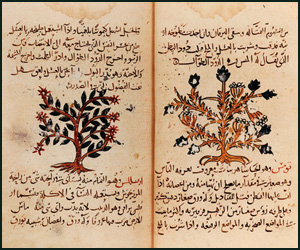|
Farming
Techniques
Muslim farmers
raised productivity mainly thanks to the introduction of higher
yielding new crops and better varieties of old crops, which made
possible more specialised land use, and more intensive rotation;
besides extending and improving irrigation, and spreading
cultivation into new or abandoned areas, and developing more
labour intensive techniques of farming.[1]
Again, old Eastern tradition, Yemeni
above all, is
responsible for improved soil management, `garden agriculture’,
which Glick notes, imposes the necessity of cultivating in such
a way as to preserve the maximum amount of moisture in the soil.[2]Which
hence adds the ecological dimension. Soil rehabilitation, Bolens
notes, was particularly cared for, and preserving the deep beds
of cropped land from erosion was `the golden rule of ecology,’
and was `subject to scrupulous laws.’[3]
Fertilisers were also used according to a well advanced
methodology;[4]soils
classified and enriched by various methods (other than by
fertiliser use), which included ploughing (normal and deep),
hoeing and digging.[5]The
rotation of crops, which in subsequent centuries was deemed a
crucial factor in the English agricultural revolution had a wide
practice, and together with new crops and better irrigation,
multiplied yields by three.[6]
This comes about through the joint knowledge of plants and
soils, the mastery of botanical and edaphic science.[7]Hence,
in Andalusia
,
well before the era of the English physiocrats of the 1800s,
Bolens says, this agricultural revolution was closely based on
high levels of knowledge of the life sciences and on a love of
nature which was the common gift of both the Islamic and the
Hebraic tradition.[8]
This
Islamic science
transferred straight to
its Christian successors. In Sicily
,
farming know how, in its wide variety, shows a direct Islamic
influence visible in the use of Arabic terminology. Notary acts
of the 14th-15th centuries related to
sugar farming and horticulture highlight the powerful Arabic
presence (in italic), terms such as catusu: Qadus (pipe
of cooked clay); Chaya: taya (hedge, or garden wall);
Fidenum: fideni (sugar cane field); Fiskia: fiskiya
(Reservoir); Margum: marja (inundated field); Noharia:
nuara (irrigated cottage garden); Sulfa: sulfa
(advance of credit granted to farmers); etc.[9]To
this day Malta and Gozo preserve such Islamic influence, the
more technical the jargon, the more purely Arabic the terms
become.[10]
The
Muslims alos brought new instruments that made it possible to
grow the new crops, which would otherwise have been impossible
with the typically classical agricultural methods.[11]And
this legacy is obvious in the technical jargon as well. To take
a glance at the philological correspondences alone, Serjeant
points out, -aretrum the plough is obviously related to
the Arabic root haratha, sulcus a furrow to the
word saliq, and iugum a yoke with ingerum
an acre (though less than an English acre) is evidently the same
word as South Arabian haig a yoke of oxen or, by
extension, an acre, the amount they can plough in a day.[12]
[1]
A. Watson
: Agricultural Innovation, op cit, pp 2-3.
[2]
T.F. Glick: Islamic
and Christian Spain; op cit; p. 75.
[3]
L. Bolens: Agriculture
, in Encyclopaedia (Selin ed), op cit,
pp. 20-2; at p. 22.
[4]
T. Glick: Islamic, op cit, p. 75.
[5]
Derived from A.M. Watson
: Agricultural, op cit, chapter 23.
[6]T.F.
Glick: Islamic and Christian Spain.
p. 78.
[7]
L. Bolens:
Agriculture
: in
Encyclopaedia (Selin ed); op cit;
p. 22:
[8]
Ibid.
[9]
H. Bresc: Les Jardins de Palerme; in Politique et
Societe; op cit; p. 81.
[10]
R. B. Serjeant: Agriculture
and
Horticulture; op cit; p. 536.
[11]
R.J. Forbes: Studies, op cit, p. 49.
[12]
R. B. Serjeant: Agriculture
and
Horticulture; op cit; p. 535. |
